It was once thought that the capacity for making and using tools was the trait that elevated humans above the rest of the animal kingdom — but as our knowledge of the animal kingdom grew, so did our understanding of nature’s ingenuity. Whether through intelligence or genetics, many animals make use of the world around them to live and hopefully thrive in their environments. Some of the animals craft objects into tools, while others simply find a creative use for typical items found in their environment. And in some cases, animals show a surprising bit of creativity in how they utilize their tools. Here are 9 of the most compelling animals that use tools.
9. Bottlenose Dolphin: The Inventor of the Underwater Kingdom

©iStock.com/Lefteris_
Dolphins are notorious for playing with objects they find floating in the water, but play is essentially just a way of learning how to hunt, forage and survive more efficiently out in the wild. Dolphins in the wild are known to use shells to scoop up prey and serve it directly into their mouths, but a small community of bottlenose dolphins in Shark Bay, Australia, have been seen using a tool that researchers haven’t noted elsewhere. They attach a sponge to their noses so they can forage on the seafloor without scraping or cutting their flesh. Interestingly enough, it seems to be a habit that’s passed down from generation to generation — although this behavior is primarily exhibited by females. Improvisational tool use is common in the dolphin community. Dolphins in captivity have been seen throwing objects to bait people or prey and even using tiles to scrape edible algae off of surfaces.
You can learn more about the myriad of ways that bottlenose dolphins flex their big brains here.
8. Degu: Proof an Old Rodent Can Learn New Tricks
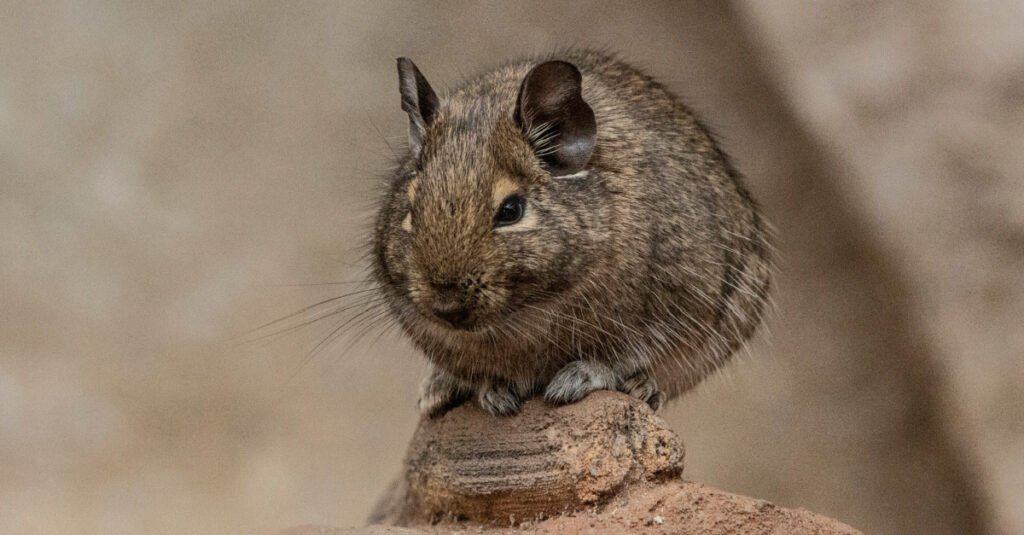
©iStock.com/Sonya Kate Wilson
The degu is a generally average-looking rodent that hasn’t exhibited much capacity to use tools out in the wild, but it could demonstrate that the ability of animals to use tools is more about the right training than an inherent instinct towards tool use. A study at Japan’s Institute of Physical and Chemical Research revealed that the promise of food was enough for a degu to connect the dots. Each animal was placed on one side of a fence that had sunflower seeds on the other side, and the only way to get to the seeds was to use a rake. It only took 60 days of practice for all six of the subjects to learn how to use the rake.
7. Long-Tailed Macaque: Understanding the Importance of Good Dental Hygiene
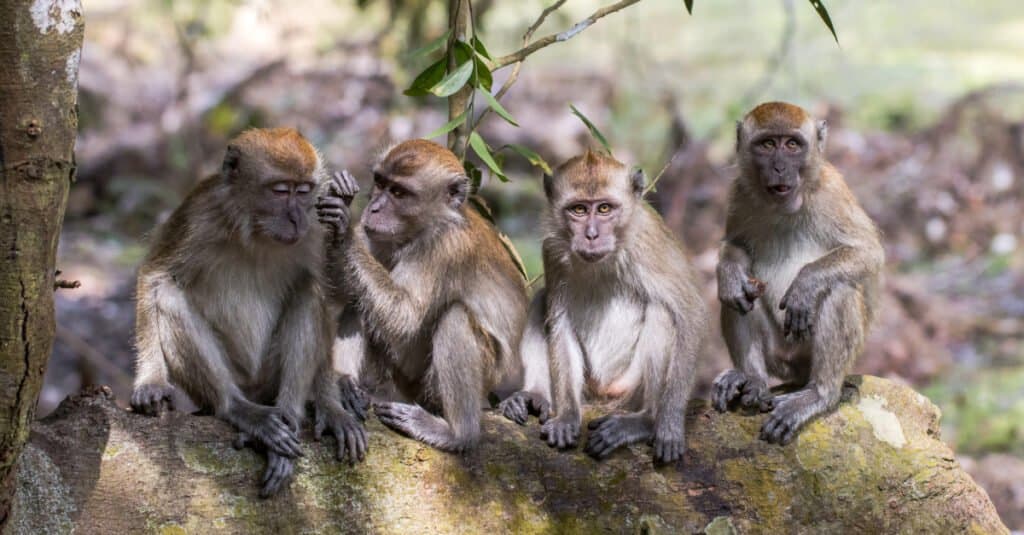
©Ken Griffiths/Shutterstock.com
The primate called the long-tailed macaque can be found throughout Thailand and Myanmar — and while all of them are capable of using stone tools, the extent to which they employ them can vary significantly. These sociable creatures separate into smaller communities, and separate isolated groups have demonstrated different levels of sophistication with tool use. Some repeatedly use tools until the point that they can show significant degradation, while others use tools sparingly and only once.
Whether it’s genetic or learned behavior, it could help us better understand the evolution of tool use in humans. But the macaques that show the most innovative use of a tool are those from Prang Sam Yot Temple. They’re known to pluck human hair from guests or visitors to use as dental floss.
The long-tailed macaque is of the most prodigious primate species in the world, and you can soak up more knowledge about it here.
6. Asian Elephant: An Analytic Problem Solver

©CherylRamalho/Shutterstock.com
Elephants have big brains to match their big bodies, and it turns out that they put them to prodigious use coming up with new types of tools. The trunk of an elephant provides them with a deft means of manipulation, and that makes them especially well-equipped to wield tools. Branches and tree trunks are commonly used for clearing brush, weighing down fences, and as a weapon either swung or thrown. But they’re also known to use smaller branches as fly swatters or as a way to scratch at itches. They’re also the rare animal that actually fashions tools rather than just making use of objects around them.
Asian elephants strip down and shorten tree branches to be more effective at swatting away flies. More surprising, elephants in captivity are capable of solving puzzles involving stacking objects to reach objectives above them and emptying water into a basin to make a treat rise within reach of their trunks.
If you don’t have the memory of an elephant, you can brush up on facts about the species here.
5. Crow: A Tool User and a Tool Builder
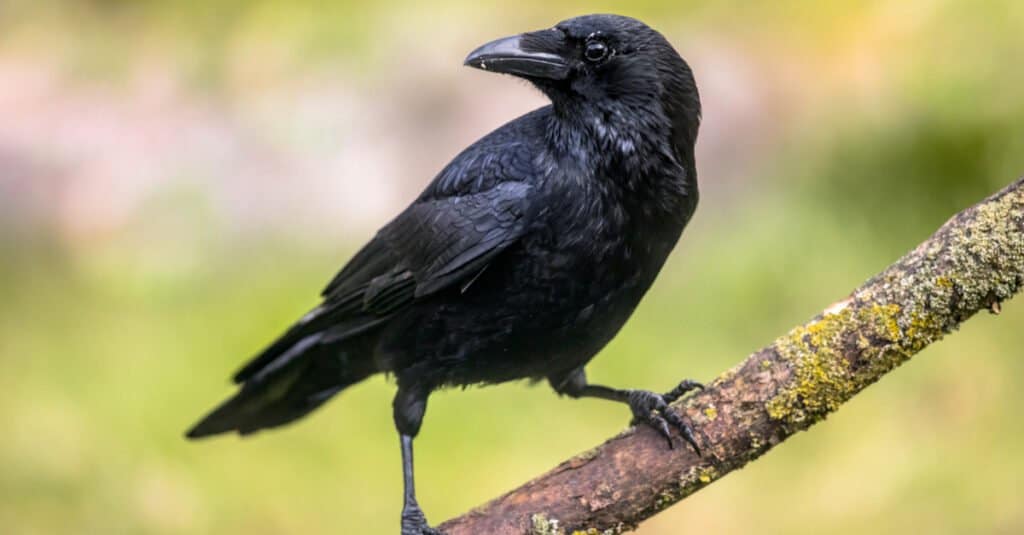
©Rudmer Zwerver/Shutterstock.com
Crows are some of the smartest birds around, and the extent of their tool use is a clear example of that. New Caledonian crows have been known to fashion tools out of paper and wood, and they’re even capable of using “meta tools”: tools that are designed to manipulate other tools. They can, for instance, fashion a smaller tool to retrieve the larger tool they need to reach the food they want. But crows are also one of the few creatures in the animal kingdom to use compound tools.
A group of New Caledonian crows in captivity was put through a battery of tests where they demonstrated they could solve puzzles that required them to combine simple objects to reach a reward. This sort of behavior hasn’t been spotted in the wild yet, but it poses exciting questions about a crow’s potential for predictive reasoning.
4. Sea Otter: A Veteran Tool User

©iStock.com/David McGowen
It was believed for decades that humans were the only creature to use tools, but it turns out that sea otters have been employing them for millions of years. Oysters are common prey for otters, but these marine mammals don’t naturally have the means to pry their shells open. Instead, they will typically reach the meat inside by planting the shell on their stomach and smashing it with a rock or by smashing the shell against a standing rock. They even tend to pick sharper and more pointed rocks for the process.
New genetic studies suggest that’s been the case for millions of years, and intensive examination of captive and wild otters suggests that tool use is genetically coded rather than learned. In fact, the indentation that some otters have on their chests could be a physiological reflection of this long-held capability.
Sea otters are still recovering from the brink of extinction, and you can learn more about their survival here.
3. Veined Octopus: Building a Better Suit of Armor
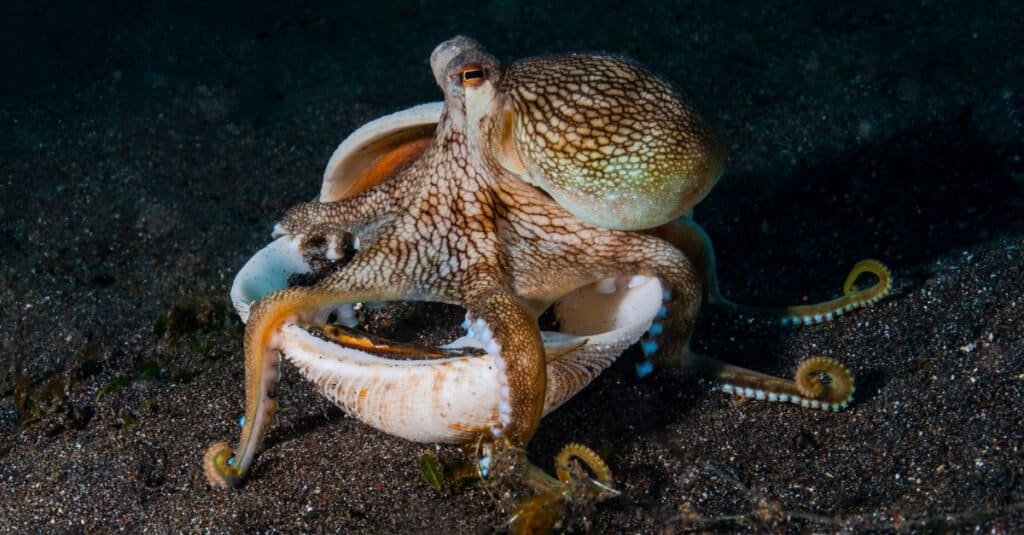
©iStock.com/atese
Hermit crabs are famous for occupying shells left behind by others, but they aren’t tool-making animals in the same way as the unique veined octopus. The difference is that these cephalopods gather and then carry coconut halves with the intention of using them later. In fact, the process of carrying the coconuts is unwieldy. They grasp a coconut half with each tentacle and carry it uncomfortably in a manner that resembles walking on stilts.
The process of carrying the coconuts is a burden, but it pays off thanks to the protection it can offer. This moment of vulnerability is worth it for the long-term advantage of having a makeshift suit of armor to hide inside. Other species of octopuses have exhibited similar but less sophisticated behaviors, like the gathering of rocks to wall-in their underwater dens.
The veined octopus is only one of roughly 400 species, which you can explore in more detail here.
2. Ant: Specialized Tools for Specialized Situations
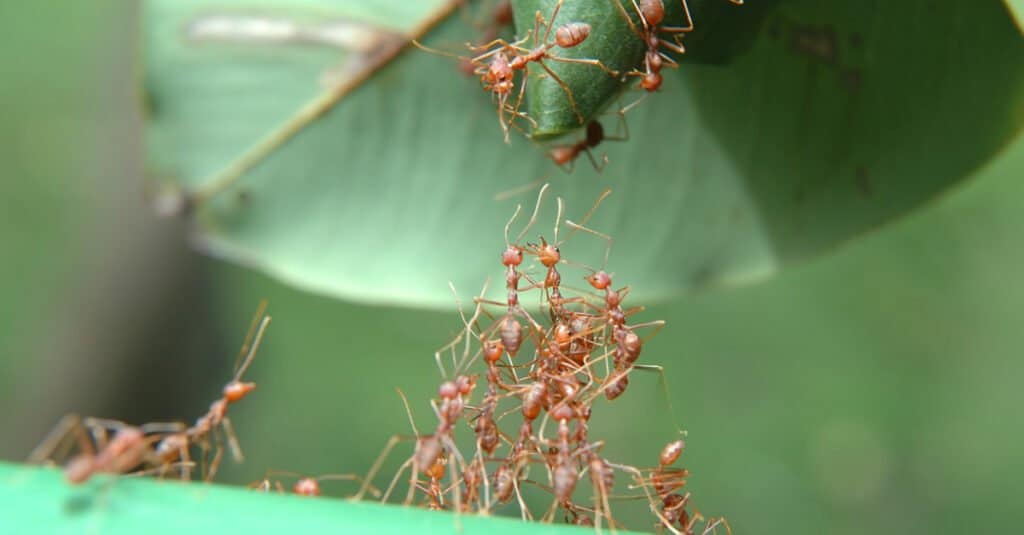
©iStock.com/clickclick1
It makes sense that the big brains of dolphins, elephants, and crows would figure out tools — but the comparatively tiny and alien mind of the ant is surprisingly adept at working with them. Funnel ants frequently carry tools to soak up and transport liquids and substances like honey — and a study by researchers demonstrates that they consciously choose objects like sponges that are best suited for the task. But in an act of more sophisticated tool use, black fire ants used sand to dilute otherwise deadly sugar water so that they could safely extract the sugar and transport it safely. Some species have even been known to farm fungus. Unlike many of the creatures on this list, it’s believed that this is almost solely the result of genetic mutations rather than higher cognition on the part of the ant.
Learn more about the thousands of ant species and their unique behaviors here.
1. Gorilla: Varied Uses For a Single Stick
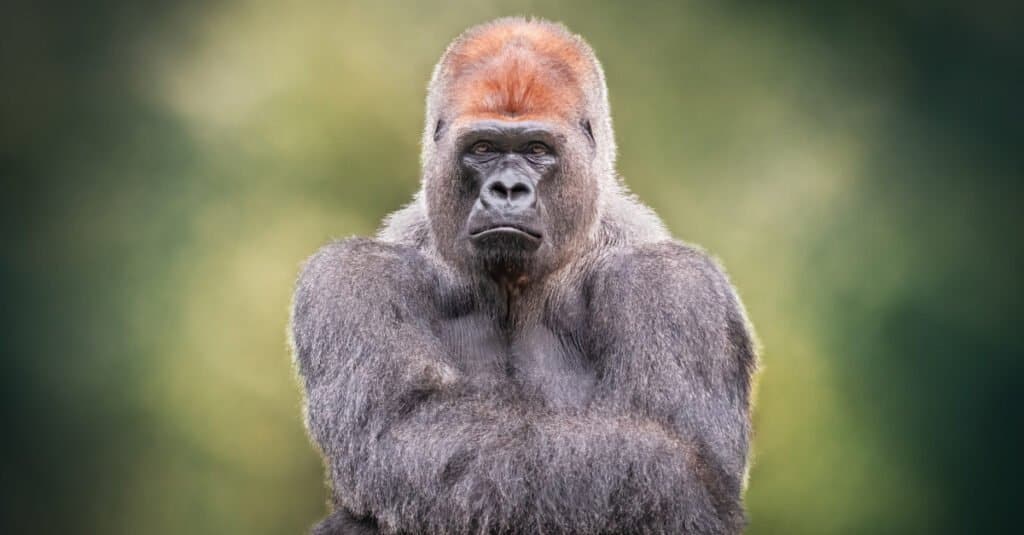
©iStock.com/SooniosPro
Many different primates use rocks to break open nuts and sticks to forage for bugs, but most can’t achieve the level of sophistication that’s been seen in wild gorillas. Observations of lowland gorillas in the Republic of Congo revealed that gorillas use sticks to measure the depth of water and even to create makeshift bridges over treacherous streams or swamps. Another breed — the mountain gorilla — is known to create de facto gloves out of thistles to prevent injuring their hands while foraging for food in thick brush. These more complicated behaviors suggest that gorillas are capable of higher-level cognition than other primates.
No matter which of the four subspecies of gorillas you’re most interested in, you can read about it here.
Here is a Summary of the 9 Animals That Use Tools
- Gorilla
- Ant
- Octopus
- Sea Otter
- Crow
- Elephant
- Long-Tailed Macaque
- Degu
- Dolphin
NEXT UP…
- Monkeys vs. Apes: The 5 Main Differences. Aren’t apes and monkeys the same thing? Maybe not.
- 10 Animals that Sing. Did you know that many animals sing? It isn’t a talent reserved only for birds.
- 10 Animals That Glow in the Dark. The list of animals that glow in the dark might really surprise you.
The photo featured at the top of this post is © iStock.com/dbar99
Thank you for reading! Have some feedback for us? Contact the AZ Animals editorial team.






